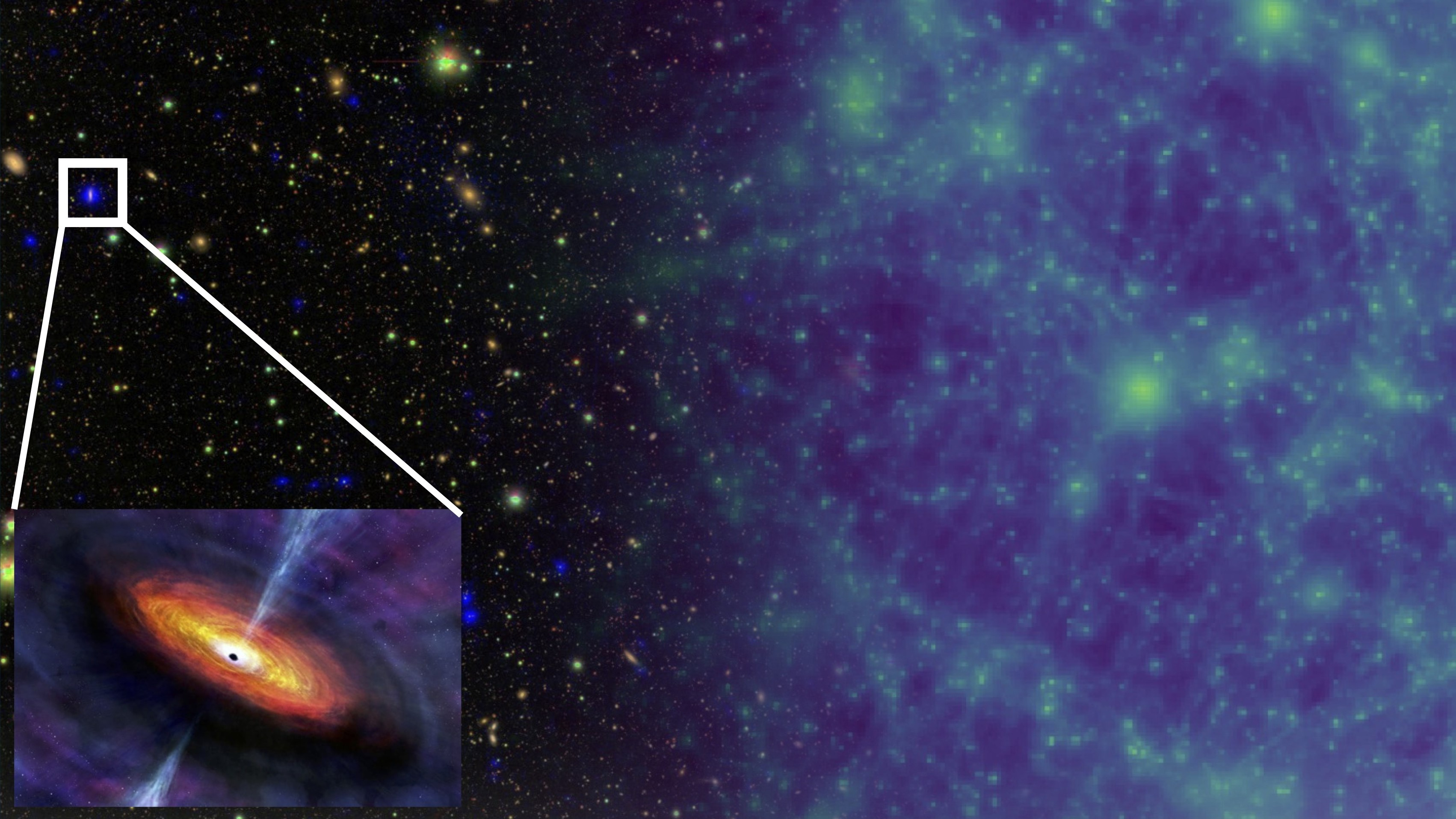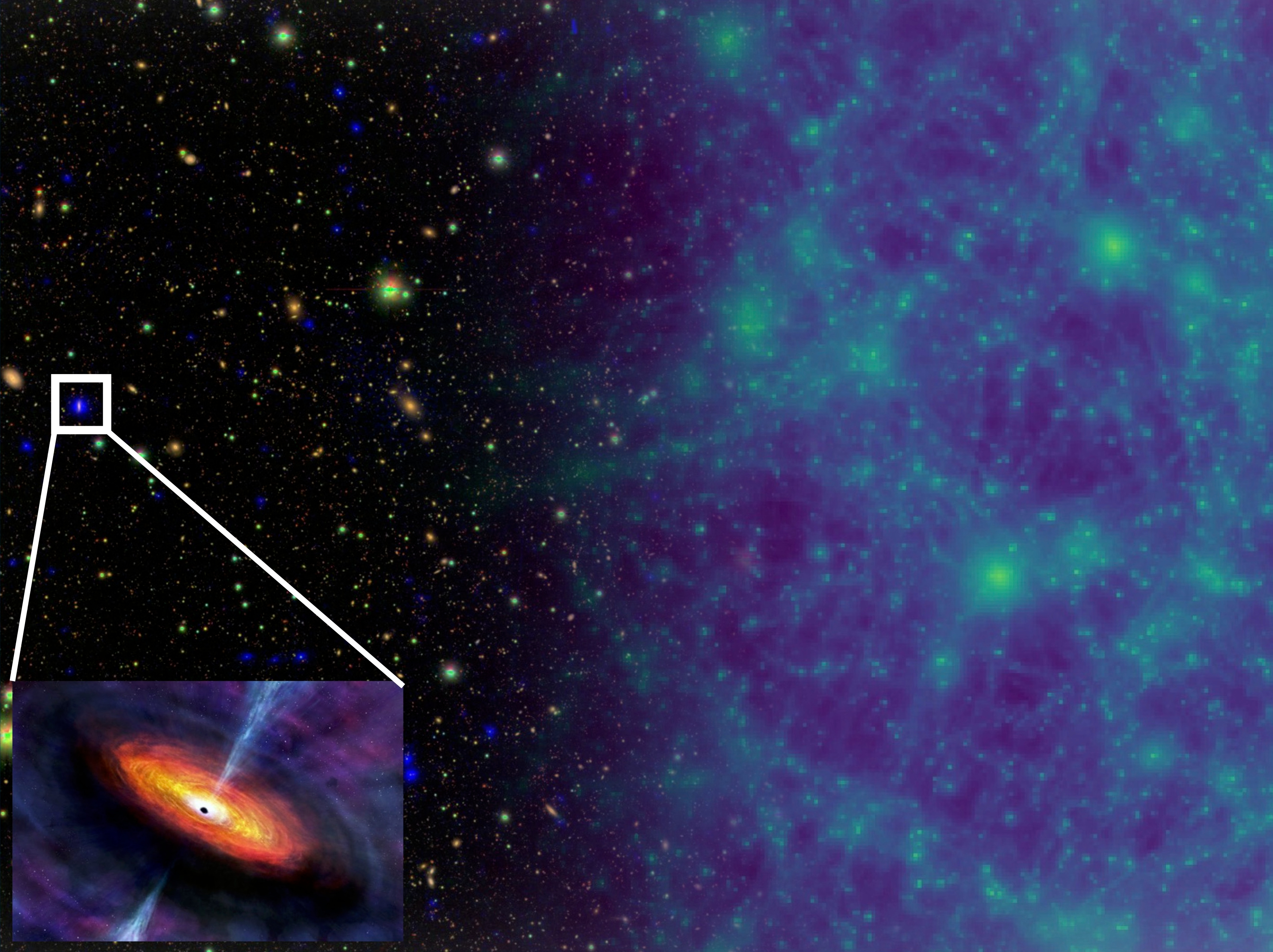12 billion years of black hole history, revealed through X-rays and simulations
Supermassive black holes at the centers of large galaxies grew mostly through the accretion of gas, with the occasional boost from mergers with other black holes.

The black hearts of galaxies have had their history told almost in full for the first time, as astronomers combined X-ray observations with detailed supercomputer models to chronicle the growth of supermassive black holes over 12 billion years of cosmic history.
In doing so, the scientists have shown that the black hole at the core of our Milky Way galaxy attained its four million solar masses relatively late in its history.
Supermassive black holes range from millions of times more massive than our sun to billions of times more massive, but their origins are unclear and how they grew to such enormous masses has been a challenge for astronomers to understand.
Now, however, astronomers Fan Zou and W. Niel Brandt, both of Penn State University, have led a team that connected the two mechanisms of black-hole growth from observations and simulations. The results may provide some answers at last.
Related: NASA telescope spots 'cosmic fireworks' and faint echos from the Milky Way's supermassive black hole
"A very big question is how do these supermassive black holes grow so massive?" said Zou while presenting their work at the 244th meeting of the American Astronomical Society in Wisconsin.. "To address that, we need to track the overall growth history of these supermassive black holes."
As mentioned, black holes grow via two main mechanisms. One is through the accretion of cold gas from their host galaxy. This gas forms an accretion disk around the black hole itself and matter from the disk gradually spirals towards the black hole's core. The accretion disk can grow so dense that friction between gas molecules causes it to heat up to millions of degrees, radiating X-rays in the process. The other mechanism occurs during galaxy collisions. When this happens, not only do galaxies merge, but their supermassive black holes also eventually coalesce and release a burst of gravitational waves.
Get the Space.com Newsletter
Breaking space news, the latest updates on rocket launches, skywatching events and more!
Tracking cosmic voids
To assess how much the accretion of gas contributes to the growth of supermassive black holes, the study team scoured through more than 20 years' worth of archival data from NASA's Chandra X-ray Observatory, the European Space Agency's XMM-Newton mission and the eROSITA X-ray instrument on board the joint German–Russian Spektr-RG spacecraft. The researchers were able to identify X-ray signals coming from about 8,000 rapidly growing supermassive black holes.
"When supermassive black holes accrete the surrounding gas they emit strong X-rays, so by detecting them in the X-ray bands we can measure their accretion power," said Zou.
They then turned to the IllustrisTNG cosmological supercomputer simulation to model galaxy mergers throughout cosmic history. From there, the team combined X-ray data showing growth through accretion with the results of the simulated mergers to gain an understanding of how and when supermassive black holes grew over the past 12 billion years, from 1.8 billion years after the Big Bang to today.
These simulations "capture the overall large-scale structure [of the universe] but also are able to probe individual galaxies," said Zou.
Supermassive black hole stories

Zou and Brandt found that the X-ray data shows accretion has been the dominant driver of black-hole growth during all epochs of cosmic history. Furthermore, the more massive the galaxy, the faster the supermassive black hole inside grew by accretion. Mergers, on the other hand, are less prominent drivers of black hole growth according to the simulations, but can still have some influence.
"Accretion dominates the supermassive black-hole growth in most cases and mergers make some notable secondary contributions," said Zou.
These results also show that supermassive black holes grew more rapidly earlier in the universe, with new ones frequently appearing. By about 7 billion years ago, however, the total number of supermassive black holes had become more or less settled with few new supermassive black holes forming. Mergers had more of an impact in later history, peaking in their importance to black-hole growth about 4 billion years ago.
"We found that once the universe reaches about 40% of its age, the overall demography of supermassive black holes is very similar to the demography of supermassive black holes that we see in the local universe," said Zou.
The astronomers even specifically modeled our galaxy's black hole, Sagittarius A*, and concluded that it grew most of its matter relatively late in cosmic time. This growth would have been mainly through accretion, with the majority of the Milky Way's mergers with other galaxies taking place more than 8 billion to 10 billion years ago. However, the European Space Agency's Gaia mission has recently found evidence for a dwarf galaxy that collided with the Milky Way just 2 billion to 3 billion years ago. Dwarf galaxies are thought to contain intermediate-mass black holes, measuring tens to hundreds of thousands of times the mass of our sun, and it is possible that one could have merged with Sagittarius A* to boost our black hole's mass.
Because the results only take us back to 1.8 billion years after the Big Bang, they don't describe how the seeds for supermassive black holes first formed. This remains a quandary for cosmologists, particularly as the Hubble Space Telescope and the James Webb Space Telescope have found surprisingly massive black holes very earlier in the history of the universe. How they grew to be millions of times the mass of our sun in less than a billion years is currently unknown.
One paper describing the findings was published in March in The Astrophysical Journal, with a second paper waiting in the pipeline.
Join our Space Forums to keep talking space on the latest missions, night sky and more! And if you have a news tip, correction or comment, let us know at: community@space.com.

Keith Cooper is a freelance science journalist and editor in the United Kingdom, and has a degree in physics and astrophysics from the University of Manchester. He's the author of "The Contact Paradox: Challenging Our Assumptions in the Search for Extraterrestrial Intelligence" (Bloomsbury Sigma, 2020) and has written articles on astronomy, space, physics and astrobiology for a multitude of magazines and websites.
NASA spacecraft spots monster black hole bursting with X-rays 'releasing a hundred times more energy than we have seen elsewhere'
Could we use black holes to power future human civilizations? 'There is no limitation to extracting the enormous energy from a rotating black hole'










